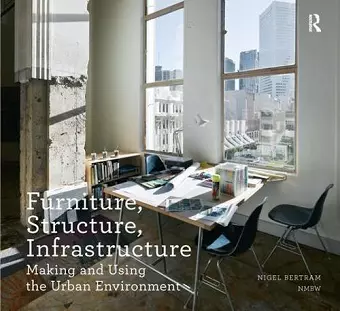Furniture, Structure, Infrastructure
Making and Using the Urban Environment
Format:Paperback
Publisher:Taylor & Francis Ltd
Published:28th Nov '13
Currently unavailable, and unfortunately no date known when it will be back
This paperback is available in another edition too:
- Hardback£190.00(9781138405486)

Observation and analysis are types of invention. They make things apparent which perhaps were invisible. By noticing, drawing and naming something we bring it into being. On the other hand, building and making can be thought of as analytical observations, pointing out what had not been so clear before and revealing the potential for other actions yet to occur. This book is a collection of urban research and architectural projects by award-winning architects Nigel Bertram / NMBW Architecture Studio, using observation as a design tool and design as an observational method. Through this process, a position on the making of architecture and on the role of architecture within the wider urban environment is established; embracing the full messy reality of the present, finding delight in the everyday and developing sensitivity to a range of found environments. By taking pre-existing conditions seriously, each project, architectural or analytical, large or small, becomes understood as the strategic renovation of a continuing state. This method of working operates by thinking simultaneously at different scales, from furniture to structure and infrastructure, searching for combinations of what might normally be separated into different categories, moving between the many small and ad-hoc actions of individuals to wider systems of collective organisation. Thinking about the effects of small moves on the larger urban field (and vice-versa), the role of unplanned or uncontrolled events in relation to the inward focus of design; thinking about the combinatory effect of what is newly made with what is already there, for example, enables architecture and the city to be understood in relative terms - in terms of relationships. Between people, groups of people, things, and parts of things, actions and groups of actions: urban architecture is the social arrangement of activity with the physical arrangement of large and small parts of its environment. But what people do also changes the place in which they do it. Considering different scales and types of relationships between individuals and groups, insiders and outsiders, expected and unexpected actions can be a way of crossing categories and establishing new relations. Breaking down components of a given situation or brief, before re-grouping, can be used to flatten and redistribute hierarchies embedded within. Similarly, finding ways of carefully observing things just as they are...
Prize: Winner of Bates Smart Award for Architecture in the Media, Australian Institute of Architects ’Recently in many architectural schools efforts intensified to further develop architectural research. Exciting new avenues are being explored, relying upon the design skills of architects and urban designers, combining them with intellectual rigor and in-depth thinking, in order to imagine new spatialities and to unfold hitherto unknown spatial experiences. This series highlights the innovative results of these explorations, opening up a new world of path-breaking research.’ Hilde Heynen, University of Leuven, Belgium 'This is a quintessential textbook that can be read in any direction ... making it very attractive to those who are time-poor ... Bertram provides an articulate and informative - albeit brief - introduction on the theme observation, which serves as a perfect primer for the subsequent read finding space, amplification, making small space, interruption/events and depth/activity ... It is a book that every student, graduate and practising architect should keep in their personal library.' ArchitectureAU
ISBN: 9781409449270
Dimensions: unknown
Weight: 929g
292 pages